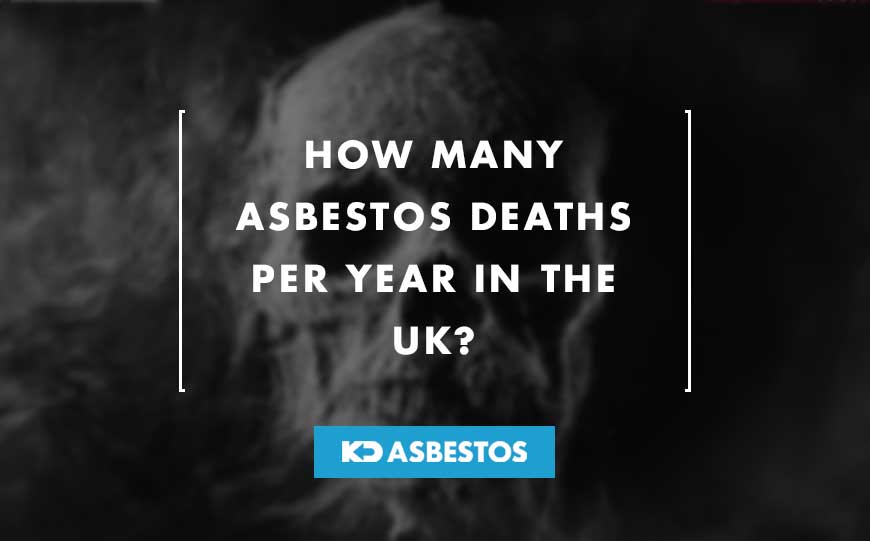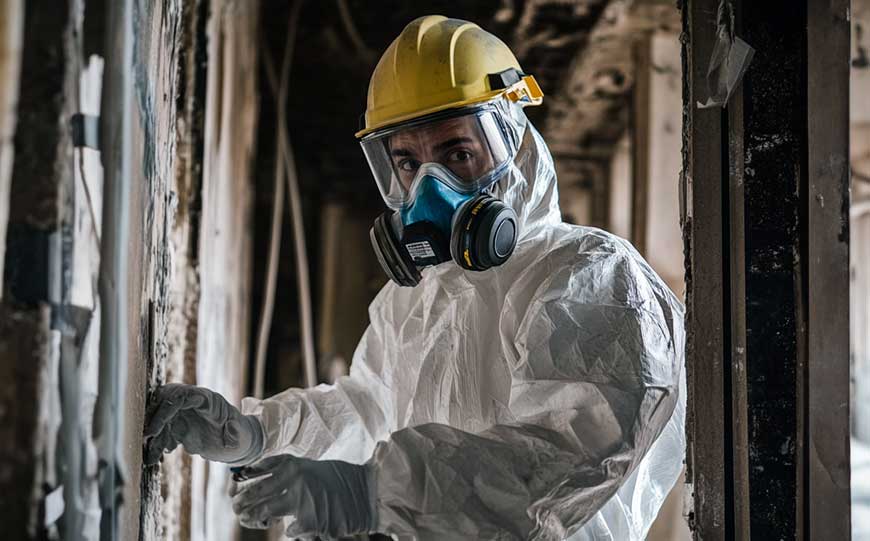
Asbestos is a hazardous material.
It was widely used in the past in the UK, and many buildings contain asbestos.
Exposure to asbestos fibres is very dangerous.
These fibres can cause serious lung damage and can lead to fatal diseases.
But how many asbestos deaths per year happen in the UK?
The deaths are caused by various diseases.
These include asbestosis, mesothelioma, and asbestos-related lung cancer.
This article will explore the dangers of asbestos, the number of deaths it causes yearly, and who is most at risk.
We will also discuss how to prevent these deaths.
Table of Contents
What are the Dangers of Asbestos?

The main danger from asbestos is due to the asbestos fibres.
Asbestos fibres are extremely small, making them invisible to the naked eye.
When asbestos-containing materials are damaged or disturbed, the tiny fibres can become airborne.
Breathing in these fibres is highly dangerous.
Once inhaled, the fibres travel deep into the lungs.
The body’s immune system cannot break down asbestos fibres, meaning they become permanently lodged in the lung tissue.
Over time, the trapped fibres cause irritation and inflammation, leading to scarring of the lungs.
This scarring makes it harder for the lungs to function properly and can result in serious health conditions.
What Diseases Does Asbestos Cause?
Asbestos exposure is directly linked to several life-threatening diseases.
The most common asbestos-related illnesses include:
Mesothelioma
Mesothelioma is a rare and aggressive cancer that affects the lining of the lungs, abdomen, or heart.
This disease is almost always caused by asbestos exposure.
Asbestosis
Asbestosis is a chronic lung disease that causes scarring in the lung tissue, making breathing difficult.
Lung Cancer
Asbestos exposure increases the risk of lung cancer, especially in those who smoke.
Why Are Asbestos-related Diseases So Dangerous?
One of the biggest dangers of asbestos-related diseases is that they often take decades to develop.
Symptoms may not appear until 20 to 50 years after exposure.
This makes it difficult to link health problems to asbestos exposure.
By the time symptoms appear, the disease is often advanced and harder to treat.
Where is Asbestos Found Today?
Although asbestos was banned in the UK in 1999, it remains in many older buildings.
Asbestos can still be found in:
- Insulation materials
- Ceiling tiles
- Roofing sheets
- Floor tiles
Renovation, demolition, or maintenance work can disturb asbestos materials, releasing harmful fibres into the air.
How Many Asbestos Deaths per Year in the UK?

Asbestos-related diseases cause thousands of deaths each year in the UK.
According to government data, there are around 5,000 asbestos-related deaths annually.
These deaths are linked to illnesses such as asbestosis, mesothelioma, and asbestos-related lung cancer.
Each of these diseases has different symptoms, severity, and long-term impacts.
However, they all share the same cause – exposure to asbestos fibres.
Asbestosis
Asbestosis is a long-term lung disease caused by inhaling asbestos fibres.
These fibres become lodged in the lungs, causing scarring and inflammation.
Over time, the scarring makes it harder for the lungs to expand and take in oxygen.
This leads to breathing difficulties, coughing, and chest pain.
Asbestosis develops slowly, often taking decades to show symptoms.
Once the disease starts, it gradually worsens. In severe cases, patients require oxygen therapy to help them breathe.
Asbestosis can eventually cause respiratory failure, making it a life-threatening condition.
In 2022, there were 493 recorded deaths from asbestosis in the UK.
Many of these deaths were linked to workplace exposure in industries such as construction, shipbuilding, and manufacturing.
While there is no cure for asbestosis, the disease is entirely preventable by avoiding asbestos exposure.
Mesothelioma
Mesothelioma is one of the most serious asbestos-related diseases.
It is a rare form of cancer that affects the thin lining of the lungs, abdomen, or heart.
Nearly all cases of mesothelioma are caused by asbestos exposure.
Even low levels of exposure can cause this aggressive cancer.
In 2022, there were 2,257 mesothelioma deaths in the UK, making it one of the leading causes of asbestos-related deaths.
The disease has a long latency period, often taking 20 to 50 years to develop after asbestos exposure.
This means many people who were exposed decades ago are only now being diagnosed.
Mesothelioma is difficult to treat.
Most patients are diagnosed at an advanced stage when treatment options are limited.
Survival rates are low, with many patients living less than a year after diagnosis.
The high number of mesothelioma deaths highlights the lasting dangers of asbestos exposure.
Asbestos-related Lung Cancer
Asbestos-related lung cancer is another major cause of death.
It occurs when asbestos fibres damage lung cells, leading to cancerous growths.
This type of lung cancer is more common in people who smoked while being exposed to asbestos.
The combination of smoking and asbestos exposure greatly increases the risk of developing the disease.
The exact number of asbestos-related lung cancer deaths is harder to measure.
However, experts estimate that asbestos-related lung cancer causes as many deaths as mesothelioma.
This means around 2,000 to 2,500 deaths each year in the UK could be linked to asbestos-related lung cancer.
Lung cancer caused by asbestos often develops without early symptoms.
By the time it is diagnosed, the disease is usually at an advanced stage.
Treatment options are limited, and the survival rate is low. Preventing asbestos exposure is the only way to avoid this deadly disease.
Who is at Risk of Asbestos-related Deaths?

Even though asbestos is banned, some groups are at a higher risk of asbestos-related diseases.
Workers in High-Risk Industries
Workers in certain industries face the highest risk of asbestos exposure.
The construction, shipbuilding, and manufacturing industries have historically had the highest exposure levels.
These industries often used asbestos materials for insulation, fireproofing, and building components.
Many workers were unknowingly exposed before strict asbestos regulations were introduced.
Older buildings can often contain asbestos.
Renovation, demolition, or maintenance work can disturb asbestos materials.
This releases microscopic fibres into the air.
Workers in construction, electricians, plumbers, and builders face the greatest risk.
Without proper safety equipment, these workers can inhale asbestos fibres without realising the danger.
Secondary Exposure
Asbestos exposure is not limited to those working directly with the material.
Family members of workers can also be at risk through secondary exposure.
This happens when asbestos fibres are carried home on clothing, hair, or tools.
Washing contaminated clothes or simply being near the worker can expose family members to asbestos fibres.
Women and children are particularly vulnerable to this type of exposure.
Environmental Exposure
People living near old industrial sites or asbestos factories may also face exposure risks.
Asbestos fibres can linger in the air or soil for years.
When disturbed by wind, construction work, or ground movement, these fibres can become airborne and inhaled by residents.
Smoking and Asbestos Exposure
Smoking greatly increases the risk of developing asbestos-related lung cancer.
When smoking and asbestos exposure are combined, the risk becomes much higher.
Smokers exposed to asbestos are significantly more likely to develop lung cancer compared to non-smokers.
Vulnerable Groups
Women are generally less likely to work in high-risk industries.
However, they can still face exposure through secondary contact or living in older buildings.
Children are at lower risk but can still be exposed if asbestos materials are present in homes or schools.
How Can You Help Prevent Asbestos-related Deaths?

Preventing asbestos-related deaths requires a combination of awareness, safety measures, and strict regulations.
Both individuals and organisations play a role in reducing the risks of asbestos exposure.
By following proper procedures and promoting asbestos safety, the number of asbestos-related illnesses can be significantly reduced.
Raising Awareness
One of the most important steps in preventing asbestos-related deaths is raising awareness.
Many people are unaware of the dangers of asbestos, especially those living in older homes.
Public education campaigns can help highlight the health risks associated with asbestos exposure.
People need to understand where asbestos might be found and why it is so dangerous.
Educational materials should explain how to identify potential asbestos-containing materials and the importance of leaving them undisturbed.
Schools, workplaces, and community centres can play a role in spreading this knowledge to help protect vulnerable groups.
Government Regulations
Government and industry bodies must enforce strict asbestos regulations.
In the UK, asbestos was banned in 1999, but many older buildings still contain asbestos materials.
Property owners, landlords, and employers are responsible for identifying and managing asbestos risks.
Regular asbestos surveys should be carried out in older buildings to locate asbestos materials.
Once asbestos is found, detailed management plans must be in place to ensure the materials remain undisturbed or are safely removed by licensed professionals, such as us here at KD Asbestos.
Health and safety regulations require employers to protect workers from asbestos exposure.
This includes providing protective gear, carrying out risk assessments, and offering asbestos awareness training.
Safe Removal and Disposal
If asbestos materials need to be removed, only licensed asbestos removal professionals should carry out the work.
These experts follow strict safety protocols to minimise fibre release.
Workers must wear protective suits, gloves, and respiratory masks to avoid inhaling fibres.
Homeowners or businesses planning renovations or demolition work should always hire professionals if asbestos is suspected.
Attempting to remove asbestos without proper training can increase the risk of exposure.
Proper disposal of asbestos waste is also essential.
Local councils provide guidance on how to dispose of asbestos safely.
Asbestos waste must be sealed in labelled bags and taken to approved disposal sites.
Personal Protection
The public can take steps to protect themselves from asbestos exposure.
If you suspect asbestos is present in your home, do not disturb the material.
Instead, contact a professional asbestos surveyor to assess the situation.
If asbestos is found, follow the recommended management plan to avoid disturbing the material.
Never attempt to remove or dispose of asbestos yourself.
Report any concerns about asbestos in public buildings to the local council or property manager.
Medical Surveillance
Medical surveillance plays a vital role in preventing asbestos-related deaths.
Workers who have been exposed to asbestos should undergo regular health check-ups to monitor for early signs of asbestos-related diseases.
Health professionals and researchers also help track asbestos-related illnesses.
This data can improve safety policies and highlight high-risk areas.
Early detection of diseases such as asbestosis and mesothelioma improves treatment outcomes and can potentially save lives.
Conclusion
You should now know how many asbestos deaths per year are in the UK.
Asbestos remains a serious public health concern in the UK.
Thousands of people die each year from diseases caused by asbestos exposure.
These deaths stem from asbestosis, mesothelioma, and asbestos-related lung cancer.
The risk is highest for those with occupational exposure, but many others are also affected.
Preventing asbestos-related deaths requires strong regulation, public awareness, and safe work practices.
Early detection and proper treatment can save lives.
We must all work together to reduce exposure and prevent further loss of life.
By taking action today, we can protect future generations from the deadly effects of asbestos.
For more information, or help with any of your asbestos-related needs, get in contact with us here at KD Asbestos.